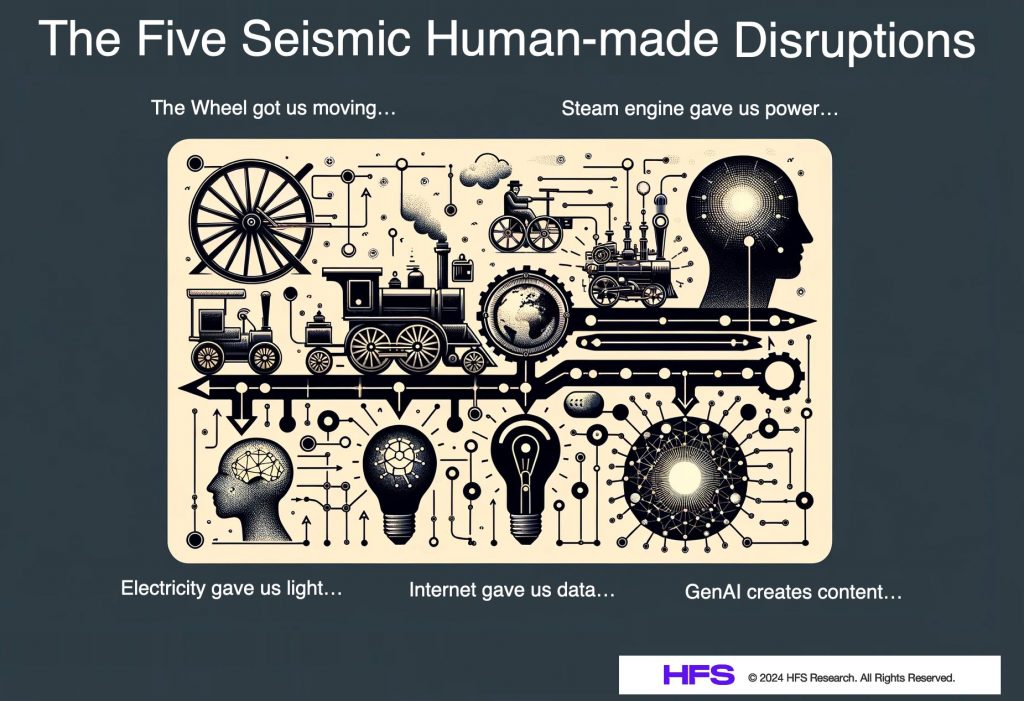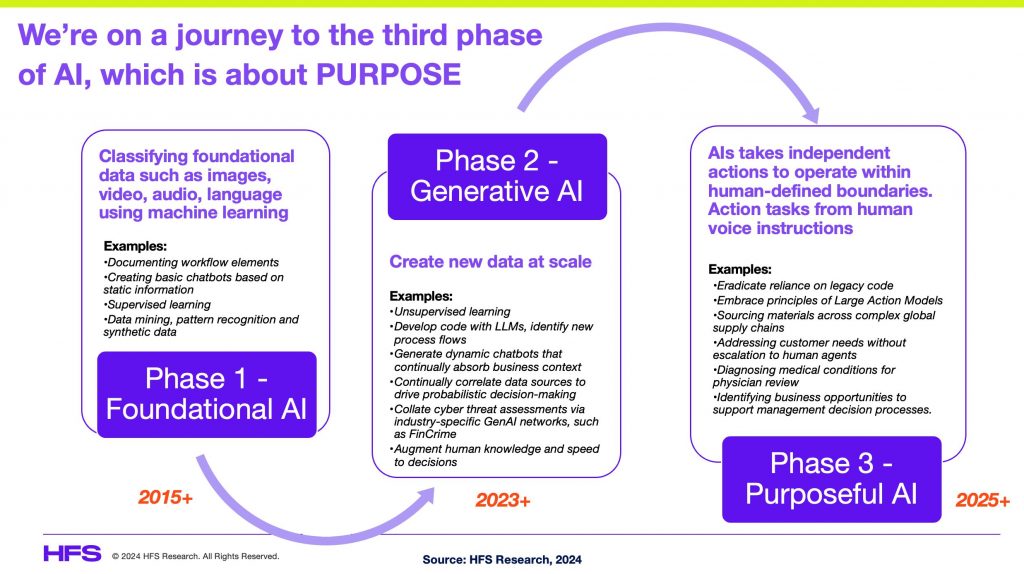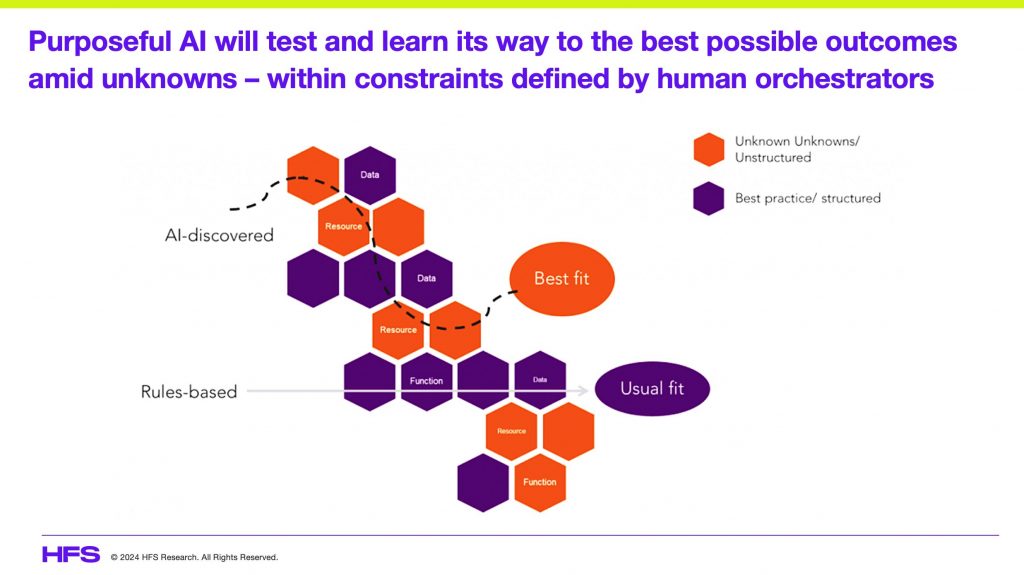Prepare to hand over the day-to-day running of your business to a new phase of AI that is driven by purpose. You create the purpose and your AI will deliver for you within the boundaries you create.
It will find you the best suppliers that sense and respond to your firm’s needs. It will address customer service needs – empowered to offer and deliver anything from apologies to recompense and implement ongoing improvements. It may even provide health diagnoses, issue prescriptions, and identify when and where a human doctor needs to intervene. And it will do all this without checking with a human while your enterprise leaders are free to focus on choosing and delivering their strategic goals.
This ‘Third Phase of AI’ follows from Foundational AI and Generative AI and is designed to make independent decisions – acting with autonomy within human-defined boundaries. Purposeful AI goes beyond a one-time-only assembly of rules of engagement. It will learn from its interactions and from prompts provided by humans to constantly improve its capabilities to action their desired outcomes in real-time:
Phase 1: Foundational AI is the bedrock on which to build generative and purposeful solutions
Each of the phases of AI illustrated above has a value proposition, and while Phase 1 represents the basic technology, it is an essential first step for extracting greater value from AI. It is in Phase 1 where we’ve learned how to organize and use data in a way that can learn and become useful for workflows and interactions. For example, Foundational AI has been in use for many years within the content moderation function of enterprises, particularly when dealing with online user-generated content. Its remit is to categorize and flag images or text that meets specific criteria (typically false, unethical or offensive content); red-flagging this content allows the humans-in-the-loop to decide whether the content needs to be removed, and in turn helps keep online communities safe. Another Foundational AI example that’s been used for years in sales, marketing, and customer service is in next-best-action strategies, where the AI analyzes customer interactions such as web visits, clicks, past purchases, etc. in order to recommend the best offer to make or content to push to the customer at the right time. This stepping stone makes it easier to see that potential of Generative AI is not not just to offer up predetermined next steps but actually to generate the content for even further personalization and speed.
Phase 2: Generative AI scales AI’s application of data to generate rapid outcomes
Phase 2 is more about how you can use AI at scale; applying Generative AI to vast amounts of information and asking it to create rapid content. Since the widespread launch of GPT 4 last year, we have been gifted with software providing an incredible ability to generate human-like text, understand and respond to queries, perform simple tasks, and even hold a conversation.
Code-writing is vastly improved, there is a natural ability to respond to emotions expressed in text, you can accurately generate and interpret text in various dialects and languages, solve complex mathematical and scientific problems – and you can even develop optical capabilities that supercede the Metaverse. The significance of GenAI to enterprises is hugely disruptive when we look at the evolution of new technologies and their ability to change industries radically:

In one use case we heard during our Generative AI Horizon report, a ChatGPT solution was implemented for media monitoring, extracting metadata from large volumes of media articles across many channels and countries to categorize, summarize, and provide sentiment analysis. This ultimately negated the heavy lifting from media analysts, allowing them to leverage the AI-generated summaries and instead focus on the output of the marketing reports. HFS Research also has Phase 2 in production on our website, where rather than use a basic web search, research clients can ask our LLM a question and receive a natural language response generated from all the research on our website.
In terms of rapid improvements with code development, one major enterprise, for example, has just concluded it can remove 15% of its IT staff from application testing by running an LLM against its testing processes (an emerging practice we are terming generative quality assurance). And this is just the start as we learn of many similar projects where LLMs erradicate significant amounts of time and labor investments dedicated to routine code development and application testing. When you consider that 20-30% of revenues for Indian-heritage IT services providers involve testing and quality assurance, it’s clear there is growing pressure to weave GenAI into bread-and-butter IT areas like testing, routine maintenance and development, and we predict this will be in full effect across IT services in the next few months.
Purposeful AI is empowered AI that performs actions requested by humans
Phase 3 takes the principles of 1 and 2 to the next level but leverages multiple technologies and an ecosystem to get the human out of the loop. The humans set the goals and the boundaries, and your AI is empowered to deliver on the actions. We opined on the enterprise potential for Purposeful AI in the enterprise (fueled by LAMs) in our recent blog post on emerging LAM tools such as the Rabbit R1. While nascent in the enterprise outside of advanced robotics (see more below), the potential use cases are compelling, if Purposeful AI is able to navigate the complex apps ecosystem that is today’s enterprise. Imagine asking your digital assistant to onboard an employee which automatically executes tasks such as device procurement, enrolling their benefits, setting up training etc? Or demand planning, forecasting, and then optimizing a supply chain network at the click of a button? Or your marketing AI companion setting up a podcast session for you, making suggestions of who to invite and how to promote over your social networks etc? Or a Soc-2 security audit that automatically delivers the governance plans and requests actions from your employees? These examples are likely not be far off…
Enterprises must also prepare for their customers to use similar technology. According to Deep Mind’s Mustafa Suleyman, the technology may be catching up. All of this strongly suggests a revolution in marketing, sales, go-to-market, and procurement that brands and organizations must start developing strategies in response to, plans that place the digital customer- as an Independent AI – at their heart.
Humans will be out of the loop, but orchestrating the loop
To deliver these benefits, humans must stop micro-managing bots’ in the loop’. Humans will be ‘out of the loop, but orchestrating the loop’. Human orchestration will mean business leaders maintain strategic control and remain accountable – by defining the boundaries they set for these bots. As natural language and voice capabilities improve, leaders will be able to issue voice commands to offer strategic direction to their independent bots and the change in guidance will be enacted immediately. Bot independence means we can release the bots to make high-speed decisions in line with the strategic goals we set directly – and all day, every day.
Their job will be to create end-to-end processes across ecosystems, making live connections between the best possible capabilities to serve the best possible outcomes – as defined by human orchestrators:
Purposeful AI is alive and kicking in advanced robotics
Purposeful AI is already a thing in advanced physical robotics. No human is in the loop when a Boston Dynamics robot moves around an unknown environment. It is making live decisions and acting on those within constraints set by a human. According to the company, the next generation of robots will be “smarter, more agile, more dexterous, and more like people”. The intent is for them to be able to take on human tasks in high-risk environments or provide care where human carers are in short supply, for example. It seems the human workforce faces a pincer movement– robotics replacing physical labor while independent bots threaten knowledge work.
The Bottom Line: Purposeful AI will disrupt how work gets done and how companies interact with their customers, suppliers and employees
Add the rise of Purposeful AI to your risk register now. It is hard to imagine a department or function of any enterprise that won’t be impacted – from sales to production, marketing to procurement. The most prepared enterprises for what-comes-next will be those which are already making advances in the AI revolution towards managing their purpose orchestrating AI’s actions. There is little chance you will be ready to move to Phase 3 if you do not first journey through phases 1 and 2.
Look out for HFS advice on assessing your AI maturity – coming soon…
Posted in : Analytics and Big Data, Artificial Intelligence, Buyers' Sourcing Best Practices, Customer Experience, Design Thinking, Employee Experience, GenAI, Generative Enterprise, GPT-4








